The beauty of the UK's loneliest bus stops
- Published
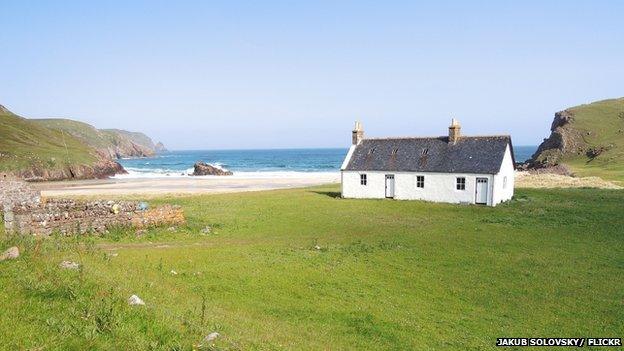
The Magazine recently visited an isolated, slate-roofed shelter in rural Cumbria and asked whether it was the UK's loneliest bus stop. A number of readers suggested even more solitary alternatives.
Serving the village of Milburn in the Eden Valley, England's most sparsely populated area, the Cumbrian stop might see "the odd walker in summer, but nobody now", according to one driver. But locals suggested it might be used by as many as six or seven passengers a week.
But it faces stiff competition. Readers of the Magazine were quick to highlight stops which no bus would deign to visit, and others where a village location would be considered lavish.
A selection of their nominations is below.
The Shaun the Sheep stop - North York Moors
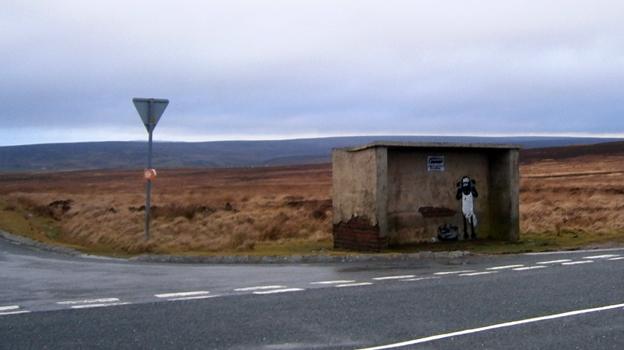
On the northern edge of the North York Moors National Park sits a decaying brick shelter set "in splendid isolation at a road junction in the middle of nowhere", says transport information officer Di Wright.
The only houses visible from the stop are miles away, on the other side of the Dale, and anyone hoping for a ride is likely to face a long wait.
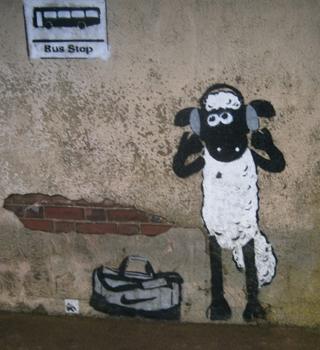
Shaun the Sheep has been waiting at a desolate North York Moors stop for a year or so
"Currently the stop is served by one bus service, the 26. This comprises one bus, every other Thursday - to get to the nearest town, Guisborough, on market day," says Wright.
Exactly who uses the stop - at Commondale Road End - is difficult to discern.
"I guess only the occasional walker used the stop, or the odd cyclist stopping for a picnic, as any local would have to drive to it," says Wright, who lives in nearby Castleton and drives past it most days.
Fortunately, anyone finding themselves waiting there has options for passing the time.
On a fine day, particularly when the heather is in bloom, the view is "stunning".
But should the rain settle in, there's always the "excellent" Shaun the Sheep graffiti - which appeared in the past year or so - to admire as the hours and days pass by.
Islay Airport's sheep shelter
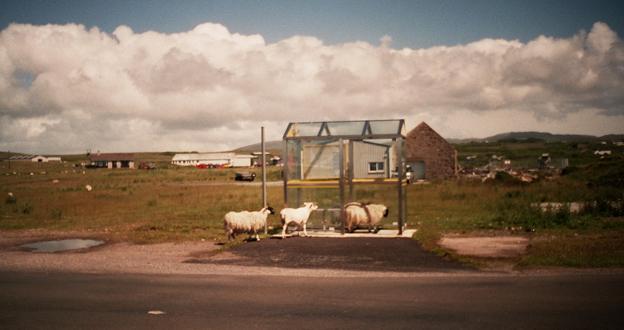
Sheep find themselves untroubled by would-be bus passengers on Islay
At a bus stop on the island of Islay, it is real sheep that sometimes make themselves at home, reports Alex Cunnigham.
Undisturbed by would-be passengers at the stop outside Glenegedale Airport - which has several flights a week to Glasgow, Oban and Colonsay - the sheep were able to make it their own.
Cunnigham, from Hawick in the Scottish borders, suggests that the creatures were "sheltering from the weather".
To be fair, the airport bus stop is not particularly lonely, served as it is by several buses a day - although Cunningham, who has visited the island a number of times, says he has never seen a bus or passenger there.
It could be that the sheep simply get to do what they want.
Images from Google Street View, external reveal that the airport is one of presumably very few in the UK to incorporate a cattle grid into its perimeter security.
The bus stop known as '3300BA0497'
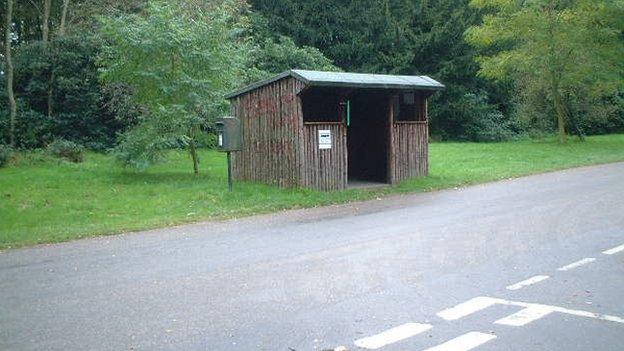
"There is an old wooden bus shelter found deep in Clumber Park, known to me and my team as 3300BA0497. To others it is simply 'Cricket Ground'," says Craig Garrard.
Working for Nottinghamshire County Council's transport department, Garrard installs and maintains bus stops and shelters across the region.
"Sadly, this means I'm quite aware of which bus shelters are where and what runs past them," he says.
3300BA0497 is in the middle of beautiful woodland and parkland on a 3,800 acre National Trust property, external, but has not seen a regular service "for many years".
But all is not lost. While there may be an absence of buses, there could be some hope of company on a rainy day.
"At least it can still provide shelter to those visitors who have been caught out by a passing shower whilst exploring the grounds," says Garrard.
"If you've parked at the visitors centre then chances are you've been past it."
The 23A to an abandoned village

Once a year a bus service runs across Salisbury Plain to the abandoned village of Imber, says Michael Meilton.
Started five years ago by a group of bus enthusiasts, the trip takes passengers deep into an area that was evacuated by the MoD in 1943 and is now used for military training.
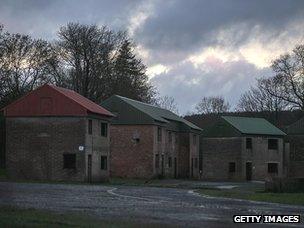
Imber is now used by the military for exercises
The 23A service takes in other remote locations on the plain, external, including New Zealand Farm Camp and Brazen Bottom and "is a normal bus service and registered with the traffic commissioners", says Meilton.
"Passengers can get on and off at any point along the route and pay a fare for the journey."
The bus stops at Imber are "not exactly isolated as they do have a ghost village nearby", admits Meilton, from Chippenham, Wiltshire.
But "no-one lives there and it is all out of bound for about 350 days a year".
There are no permanent bus stops in place but, as Gregory Beecroft who also nominated the service notes, "if stops were put up, they might not last long, because the 23A runs through the Army firing ranges".
Cape Wrath - by appointment only
The bus stop for passengers hiking down to a bothy at Kearvaig on Cape Wrath (pictured top) blows all other claims for the title of UK's loneliest "out of the water", says Kevin Roy.
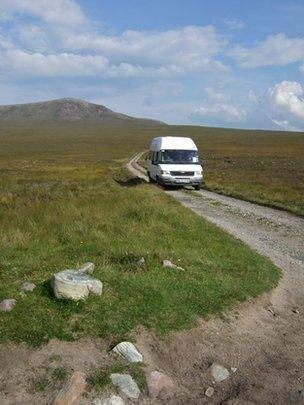
The Cape Wrath service shuttles back and forth along an 11-mile track
"The road isn't even connected to the rest of the UK road network and the two minibuses that shuttle between Cape Wrath and the Durness passenger ferry are the only non-military vehicles that ever travel on it.
"The bus stop is merely a junction of tracks on a bleak moorland used as a target range by the armed forces, and is not marked by any sign."
The 11-mile route ferries passengers by minibus around the most north-westerly point of the British mainland, external, which can only be reached by ferry.
And there is no regular timetable, warns Roy.
"The bus drivers will drop you off or pick you up there by arrangement."
It was while waiting here with his wife for a bus that did not arrive that Roy, a technician from Luton, realised that he was at "the end of the earth".
"With dusk and the time of the last ferry approaching, we were alarmed to be waiting on the bleak open moorland for hours."
Their bus had broken down and, eventually, it fell to the driver of the other vehicle to get them to the ferry on his last trip of the day.
Other nominations
Among the many other suggestions for loneliest stop was one on the Isle of Wight named "Middle of Nowhere, external". "Funnily enough, it's in the middle of nowhere," says Ben Elias, from Hailsham.
In North Northumberland's Glen Valley, a service runs between Kirknewton and Wooler once a week on a Wednesday, says Phil Sage. "It is a vital link for those in the area for shopping, medical appointments and catching up for coffee."
Another weekly service is nominated by Jack Craven of Guiseley, Leeds, who says there is a further catch - it operates only "on Sunday mornings in the summer".
A stop on an A-road in Thorpe Abbotts, Norfolk, is suggested by David Bizley from Woking, who says "the only indicator that there is a bus stop is a slowly collapsing wooden shed". Having used it when staying with his parents, he finds its existence is a surprise to others, as demonstrated by "the confusion and subsequent rapid braking of the driver".

Is anywhere 'lonelier' than a big city bus stop?
Further afield, but worthy of consideration, is a once a week service from Adrar Bordj Mokhtar in southern Algeria, where there are no proper roads for 400 miles across desert, says Chris Lewis, from Purley.
"If you wanted to sample what is arguably the world's loneliest bus stop, you could in theory get off at an abandoned Foreign Legion post and then wait for the returning bus to pick you up - if you were still alive, that is."
And then there's the problem posed by Eddie Dealtry, from Kendal.
The loneliest bus stop, he suggests, will be neither rural nor seldom-used, but "surely somewhere in one of those cities where people ignore each other".
Follow @BBCNewsMagazine, external on Twitter and on Facebook, external